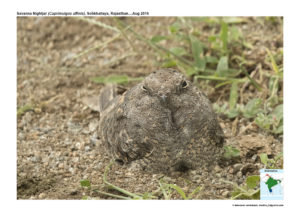
SavannaNightjar Caprimulgus affinis
Etymology:
- Caprimulgus : Latin word capra – goat; mulgere –to milk . The nightjar were assumed to drink goats milk and injure the goats
- Affinis : Latin word for “Related”
Vernacular Names: Lepcha: Tamor, Guj: Franklin-no chhapo, Chabukdasharadhiyu, Hindi: Franklin chapka, Mar: Franklins Ratwa
Distribution in India: Widespread resident in India.
Description: Size of 22-23 cm. They are sexually dimorphic. The upperparts brown, speckled whitish or cinnamon and streaked blackish-brown; pale buffish, cinnamon or whitish nuchal collar; lesser coverts brown speckled pale buff, rest of wing-coverts paler, boldly spotted pale buff; scapulars blackish-brown, broadly edged buff or whitish on outer webs; buffish submoustachial stripe and small white patch on either side of lower throat; underparts brown, barred, speckled and spotted buff and cinnamon, becoming buff barred brown on belly and flanks. The male has large white spot on four outermost primaries, and two outermost tail feathers are generally white, tipped or edged brownish; female has buffish wing spots and no white in tail, Iris dark brown, bill blackish, legs and feet brown.
Habitat: It is found in grassland, grassy plains and open woodland and forest, often with scrub or rocky outcrops; also arable land, stony or sparsely vegetated hillsides and barren ridges, edges of swamps and mangroves, sandy or shingly beaches, bare sand or riverbanks, dry stony riverbeds with growth of scrub and grass, coastal scrub land; from sea-level to 1500 m.
Food Habits: It eats moths, helipterums, flying ants, grasshoppers, locusts, cockroaches, small wasps, termites and other insects. It is most active, and mostly feed, near dawn and dusk (crepuscular – active during the twilight). At dusk, they often fly around livestock to feed on insects swarming around the animals. At night, they like to take advantage of insects swarming around street lamps or other artificial light sources. They are keeping their bills wide open as they fly through clouds of small insects. It may also forage under the canopy by flying from favored perches catching insects at foliage. Larger insects are usually taken back to their favored feeding perches. While holding the insects in their bills, it keeps the head upright, shake and swallow the prey whole, or they may break the insects apart before eating. Insects may also be taken from the ground or foliage.
Breeding Habits: They breed in Apr-Aug in India.The nest-site in open, at base of tree, hidden among scrub or tufts of grass, or beneath bush; if no nest, eggs laid on bare, stony or salt-encrusted ground. They lay a clutch of 2 eggs . The incubation period is 17-18 days, commenced with last egg done by female alone. The male taking turns close to dusk and dawn.The chicks are born semi-precocial. The brooding bird, covering them closely with its camouflage plumage, is their best protection. The chicks can crawl away from the nest soon after hatching and hide among leaves when alarmed.